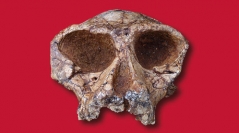

 Geodiversitas
44 (16) - Pages 471-504
Geodiversitas
44 (16) - Pages 471-504Up to the mid-1990’s, only a few remains of Cercopithecoidea were known from the Lukeino Formation (Tugen Hills, Kenya). Surveys from 1998 onwards by the Kenya Palaeontology Expedition led to the discovery of new material at Aragai, a site situated in the lower levels of the Lukeino Formation dated at c. 6-5.8 Ma. Most of the collection consists of craniodental specimens generally well-preserved in a hard matrix but there are three postcranial bones. A new taxon of fossil colobine monkey is described: Sawecolobus lukeinoensis n. gen., n. sp. It is a small to medium-sized, short-faced colobine. Sawecolobus n. gen. shares many features with Cercopithecoides Mollett, 1947, especially in the face and the calvarium, but differs from it by the less pronounced supraorbital tori. The two genera differ greatly in mandibular morphology. In Sawecolobus n. gen. the mandibular corpus is slender and not robust as in Cercopithecoides Mollett, 1947, and the anterior surface of its symphysis is inclined posteriorly and not vertical. The numerous new specimens from the Lukeino Formation contribute to our understanding of the local diversity of Miocene Cercopithecoidea and fill out the distribution of the superfamily in the continent for the same period.
Late Miocene, Kenya, Primates, Cercopithecoidea, Colobinae, Sawecolobus, new genus, new species